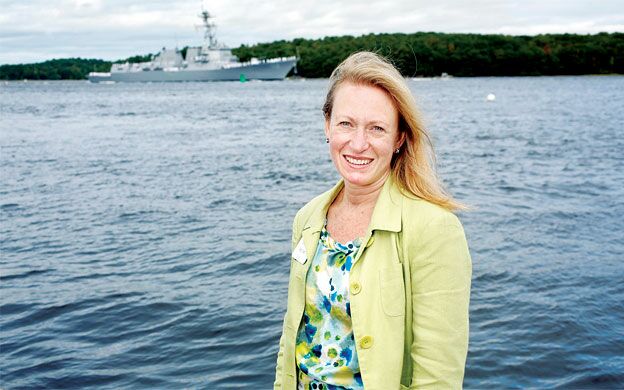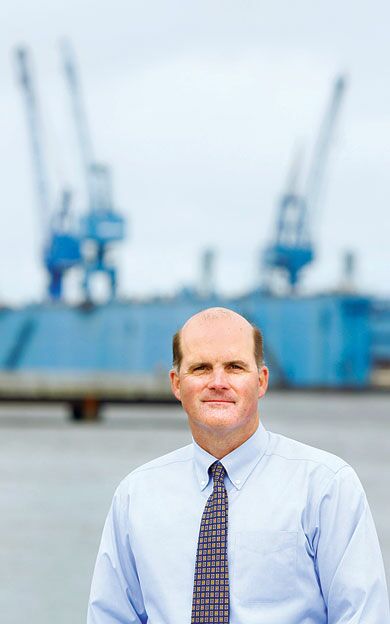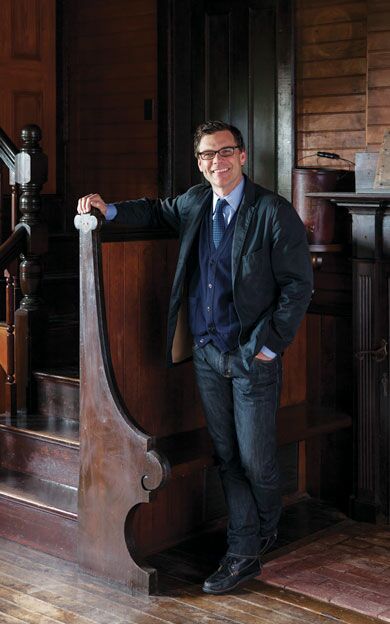Maine museums find partners in business
Amy Lent, executive director of the Maine Maritime Museum, doesn't have far to look for evidence that Maine's shipbuilding heritage is very much alive on the banks of the Kennebec River.
Bath Iron Works, founded in 1884, is a mile upriver as the seagull flies, the same by car along Washington Street. The Navy destroyers built there have only one way to reach the open ocean. With a river pilot at the helm, those 505-foot-long warships must follow the river's deepest channel past the museum's historic Percy & Small shipyard as they get ready to thread two 90-degree turns at Doubling Point just ahead. A metal sculpture of the six-masted schooner Wyoming, the largest wooden boat ever built, looms large on the museum's gently sloping grounds — a daily reminder to museum visitors and passing motorists of Bath's heyday as the "City of Ships" in the 19th century, when shipyards lined the banks of the river and the sailing vessels they built hailed at ports around the world.
Past and present are very much connected in Lent's mind, and that connection has influenced her approach to guiding the museum during her six years at its helm. With the help of corporate sponsors like BIW and its parent company, General Dynamics, and dozens of other Maine businesses, she and her team have been redefining the museum's mission in ways that go far beyond being merely a caretaker of historic artifacts.
The Maine Maritime Museum is not alone in that respect. Across Maine, museums and other cultural institutions — among them the Portland Museum of Art and the Colby College Art Museum — are key players the state's creative economy. Their prominence is getting a boost from new corporate relationships, with businesses and donors, that are helping the organizations grow despite the effects of a lingering recession.
According to the 2011 report "New England's Creative Economy: Nonprofit Sector Impact," Maine's 2,292 arts and cultural organizations spent almost $262 million in 2009, the year covered by the report, and employed 5,246 people, just under 1% of total employment in the state. When additional indirect and induced spending are added to the equation, that $262 million spurred a statewide $525 million economic impact in 2009 and a total employment impact of 7,547, according to economists Chuck Lawton of Planning Decisions Inc. and Charles Colgan of the University of Southern Maine, who were joined by the Maine Center for Creativity in authoring the 2011 report for the New England Foundation for the Arts.
Forging business partnerships
Like BIW, which has survived largely by keeping one step ahead of evolving shipbuilding trends during its 128 years, Lent says she recognized soon after taking over at the Maine Maritime Museum that its future would hinge on proactively broadening the scope of its mission. Preserving historic artifacts and telling their stories would remain the foundation of that mission, she says, but as the presence of BIW upriver illustrates, Maine's maritime history is by no means over. The museum, in her view, also has a responsibility to tell the stories that are happening now.
That realization, she says, has pushed her and the museum staff to create exhibits that show how past, present and future are linked. This broader focus, in turn, has been facilitated by partnerships she's forged with 155 businesses and nonprofits with parallel interests, such as Friends of Merrymeeting Bay and the Lower Kennebec River Land Trust.
The business partnerships are very much a two-way street: Larger sponsors such as BIW and its parent General Dynamics, Reed & Reed and Cianbro help the museum mount exhibitions it might not otherwise be able to afford. In return, they get not only the museum's affirmation of their generosity, but in some instances the resulting exhibition helps to build public awareness of their businesses and their relationship to Maine's maritime industries.
One example: Last year's "ALOFT! Topsails to Turbines" exhibit connected the bygone age of sail, with explanations of sail design, rigging variants and "flops and failures," with modern wind turbine designs that Reed & Reed and other Maine companies are erecting to tap the power of wind for electricity. Another is this year's "Honing the Edge: the Apprenticeshop at 40," which celebrates the wooden-boat revival in Maine fostered by the museum's Boat Shop, founded in 1972 by Lance Lee, who a decade later founded the Apprenticeshop in Rockland.
"The thing that makes us unique is that Maine has a very deep maritime history … it's still vibrant, it's not just recreational boating or a thing of the past," Lent says. "You see evidence of maritime activity everywhere you go — Navy destroyers being built at BIW, small lobster boats, offshore trawlers, you name it. We still have working waterfronts. A lot of places in the country don't have that. Visitors coming to Maine see the names of local boatbuilders who are still building boats at this harbor or that waterfront. These places still exist."
For smaller business sponsors, Lent says museum staff steer visitors to local restaurants, inns or hotels. Or they might pass on the names of established Maine boatbuilders to someone looking to buy a boat. Or they might answer questions from out-of-state visitors looking to retire in Maine, pointing out the other arts and cultural institutions that make the state so attractive to retirees looking for a community where they won't be isolated and bored.
Finally, Lent says the museum's river cruises give organizations like Friends of Merrymeeting Bay and the Lower Kennebec Estuary Land Trust the opportunity to convey their messages about the significance of the Kennebec and Maine's other major rivers to migratory fish species that are important food sources for ocean fish.
"There are many, many businesses and nonprofits that need exposure," she says. "The benefit of partnering with the museum is that we have an asset in the thousands and thousands of visitors who come here and who regard the museum as a trusted source of information. Those visitors are primed and ready to learn about the Kennebec River. So that's a program that has grown hugely, for us as well as them."
Economic impact of museums
"Maine museums: An economic impact study guide," a 2010 study prepared by Chuck Lawton, chief economist at Planning Decisions Inc., and Lindsay Rowe of the Maine Arts Commission, gives credence to Lent's understanding of the museum's far-reaching economic impact.
The study, based on visitor surveys conducted during the summer of 2009 at 14 museums, including the Maine Maritime Museum, found that the 442,000 visitors to the 14 surveyed museums spent nearly $71 million in 2009, a time when Maine and the nation were very much in the early throes of the worst recession since the Great Depression. That figure represents what visitors spent at the museums as well as for food and beverages, transportation, shopping and recreation — spending that supports about 1,300 jobs earning slightly more than $30 million in total income, according to the study's authors.
Maine Maritime Museum drew 45,000 visitors in 2009, the fourth highest number of the 14 museums surveyed (with the Portland Museum of Art leading with 150,000, followed by Farnsworth Art Museum in Rockland with 60,000 and Maine State Museum in Augusta with 54,500). Its percentage of out-of-state visitors was 78%, the highest of the 14 museums and well above the 60% average.
The museum's "day travel" visitors had the highest daily spending total of the 14 museums, shelling out $129 for food and beverages, transportation, shopping and recreation. That's well above the $92 daily average for the 14 museums. "Overnight" visitors spent a total of $253, slightly higher than the $243 overnight average. By comparison, overnight visitors coming to Maine to visit friends and family spent, on average $89 per day.
"Clearly, the people who visit Maine's museums are ideal tourists for Maine shopkeepers, innkeepers, restaurant owners and other local businesses," Lawton and Rowe conclude in the study they prepared for the Maine Arts Commission.
PMA and Winslow Homer
Like the Maine Maritime Museum, the Portland Museum of Art, which draws an average of 150,000 visitors per year, isn't resting on its laurels.
This month, the museum celebrates its strong connection to the Maine painter Winslow Homer (1836-1910) with two events: The grand opening of Homer's fully restored studio at Prouts Neck, where he completed some of his most famous paintings during the last 30 years of his life. Reservation-only tours, each limited to 10 people who will be driven from the museum to the studio in a van, begin on Sept. 25 for $30 to $55. A major exhibition, "Weatherbeaten: Winslow Homer and Maine," featuring 35 oil and watercolor paintings completed at the studio, opens Sept. 22 and will be on display through Dec. 30. Many loaned works have not been seen in Maine for more than a generation, making the assembled exhibition a special review of Homer's work.
"Those late works are considered some of the greatest American works of art of all time," says PMA Director Mark Bessire. "They are so tied to our American 'identity.'"
When Homer came to Maine in 1883 to stay, he already was a nationally acclaimed artist noted for his paintings of everyday 19th-century American life. But it was at Prouts Neck that he fully turned his attention to the ocean, and his seascapes of waves crashing on the rocky shore quickly became iconic images that inspired a new generation of artists to paint in Maine — among them George Bellows, Rockwell Kent, Edward Hopper, Marsden Hartley, Georgia O'Keeffe and N.C. Wyeth.
"It's the moment that Homer comes to Maine that the floodgates really open," Bessire says.
Bessire readily admits the museum's decision in 2006 to purchase and fully restore Homer's studio — notwithstanding his standing as "probably America's most popular artist" — might have seemed economically foolish. Even more so when the stock market collapsed in the fall of 2008.
But Bessire says the museum's board saw the $10.8 million project as being tied to PMA's mission statement of enriching "the lives of people through acquisition, preservation and interpretation of the visual arts and the museum's architecturally significant buildings." It also advances, he says, the museum's long-range business plan, which capitalizes on its significant collection of Homer's paintings and their stature in both national and international art circles as masterpieces of American art.
Donations and grants both large and small — 43% coming from out-of-state donors — helped the museum achieve its fund-raising goal for the studio restoration project. Bank of America signed on as sponsor of the "Weatherbeaten" exhibition. With Homer being the quintessential American artist, Bessire acknowledges "it was not a tough sell."
Bessire says the museum's restoration of Homer's studio provided work for almost 20 Maine contractors. It generated attention from Architectural Digest, Martha Stewart Living, National Geographic Traveller and Preservation Magazine, as well as local coverage by Maine newspapers and Downeast magazine. The $700,000 Winslow Homer Education Endowment will support a biennial artist residency program and an annual fellowship enabling a Colby College student to work with the museum's learning and interpretation and curatorial departments.
By telling the story of Homer's creative decision to come to Maine and how it led to his greatest works and encouraged other artists to come here, Bessire says the museum reinforces an important message: "People come to Maine to be creative. That's noteworthy, a crucial part of our story."
Lasting legacies
Tax-exempt private foundations endowed by famous artists or their estates are key players in supporting Maine's arts and cultural institutions. For example, a $4 million bequest to PMA by Maine landscape artist William Thon, who died in 2000, funds the museum's juried biennial exhibition showcasing contemporary art. Likewise, philanthropists extend support through their own foundations or outright gifts: Maine Maritime Museum's campus on the Percy & Small Shipyard in Bath was received as a donation from the late Lawrence M.C. Smith and his wife, Eleanor (whose other significant bequests include Wolfe's Neck Farm, Mast Landing and the Pettengill house and farm in Freeport).
A forum hosted by the Farnsworth Art Museum in Rockland this summer, featuring former Maine College of Art President Christine Vincent and Christy Maclear, executive director of the Robert Rauschenberg Foundation, highlighted the rising importance of artist-endowed foundations as engines in the national creative economy. A 2007 study by The Aspen Institute cited by Vincent pegged the national impact from 1990 to 2005 at $954.7 million, with 67% being disbursed as charitable contributions or grants and 33% as contributions to help cover operating and administrative expenses.
In Maine, contemporary figurative painter Alex Katz — a summer resident of Lincolnville — created a foundation in 2004 to support artists and museums through the purchase and donation of works of art. Katz's foundation has given the Colby College Art Museum more than 100 works worth more than $4 million, including six paintings by the American modernist painter Marsden Hartley.
Sharon Corwin, curator of Colby's art museum, says such gifts of notable artwork and the $15 million Alfond-Lunder Family Pavilion scheduled to open next summer, have definitely put the college's 53-year-old museum on the map both nationally and in Maine. A third of the cost was covered by a $5 million gift from the Harold Alfond Foundation, while philanthropists Peter and Paul Lunder have promised to give their collection of American art, valued at $100 million or more, to the college. When the 26,000-square-foot addition is completed, Colby's art museum will become the largest in Maine.
Corwin has no doubt that when the new wing opens it will significantly add to the museum's 20,000 annual visitors, drawing people from within Maine and beyond who are eager to see works in the Lunder collection by James McNeill Whistler, John Singer Sargent, Mary Cassatt, Winslow Homer, Edward Hopper and Georgia O'Keeffe, among others.
"There's a great museum here," she says. "We think of the museum as enriching the cultural and arts happenings in the Waterville area. It's a cultural 'home.'"

















Comments